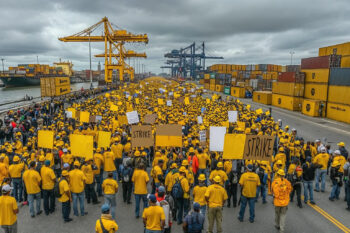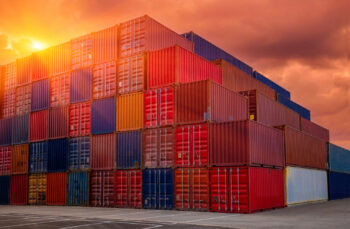Headlines
- 1 Job Growth and Travel Demand Highlight the Strength of the U.S. Economy
- 2 Misjudgment in European EV Strategy! Large-Scale Layoffs Due to Declining Competitiveness
- 3 China’s Manufacturing in Recovery Trend with PMI Above 50 But Local Governments Face Financial Crises
- 4 Labor-Management Negotiation at U.S. East Coast Ports is challenging! Automation vs. Job Protection
- 5 Container Shipping Lines See Surging Profits, Leasing Companies Remain Booming!
- 6 New Container Production Hits Decade High! New Container Information for November 2024
- 7 OECD Forecast: Global Growth Rate to Reach 3.3% by 2025 Japan to Turn Positive Growth
Job Growth and Travel Demand Highlight the Strength of the U.S. Economy
 According to the U.S. Department of Labor’s employment statistics released on December 6, non-farm payroll employment increased by 227,000 in November compared to the previous month. The unemployment rate worsened slightly to 4.2%, up from 4.1% in October. There were temporary disruptions in October, such as a major hurricane landing in southern Florida from late September to early October and the Boeing’s largest strike in 16 years, which lasted nearly two months from September to early November and was resolved with a one-time bonus and a 38% wage increase over four years. As these disruptions subsided, average hourly wages increased by 4.0% year-on-year and by 0.4% month-on-month, indicating that the U.S. employment situation remains solid.
According to the U.S. Department of Labor’s employment statistics released on December 6, non-farm payroll employment increased by 227,000 in November compared to the previous month. The unemployment rate worsened slightly to 4.2%, up from 4.1% in October. There were temporary disruptions in October, such as a major hurricane landing in southern Florida from late September to early October and the Boeing’s largest strike in 16 years, which lasted nearly two months from September to early November and was resolved with a one-time bonus and a 38% wage increase over four years. As these disruptions subsided, average hourly wages increased by 4.0% year-on-year and by 0.4% month-on-month, indicating that the U.S. employment situation remains solid.
The American Automobile Association (AAA) predicted that the number of travelers during November 26 ~ December 2 would reach approximately 79.86 million, a 2.1% increase compared to 2023. Many were expected to travel during the Thanksgiving holiday on November 28, with about 90%, or 71.74 million, traveling by car, which was 1.3 million more than the previous year and surpassing the 70.60 million in 2019. Domestic air travel was projected to increase by 2% to 5.84 million, with domestic flight bookings up 23% from the previous year. Travelers using buses, trains, and cruise ships were also expected to rise by 9%, with cruises showing a particularly strong increase of 20%.
Misjudgment in European EV Strategy! Large-Scale Layoffs Due to Declining Competitiveness
In Europe, the automotive industry plans to cut 50,000 jobs in 2024. The main cause is rising energy costs following the halt of natural gas supplies from Russia. The impact extends to parts manufacturers as well. The EU automotive industry accounts for over €1 trillion (approximately ¥161 trillion), or 7% of the region’s GDP, its impact is much more compared to 3% in Japan. The industry employs 13 million workers.
According to the German Institute for Economic Research, the electricity cost for the automotive industry in 2023 was €190 per megawatt-hour, more than double that of China and nearly triple that of the U.S. Although European countries implemented purchase subsidies and tax reductions to promote EVs, the market decelerated sharply in late 2023 as these subsidies were reduced or withdrawn. Volkswagen invested €30 billion in EV development over five years until 2022, while BMW’s R&D spending exceeded €6.6 billion in January–September 2024, a 27% year-on-year increase.
On November 25, Thyssenkrupp, a major German steel and engineering company, announced plans to cut 11,000 jobs, 40% of its workforce, at its steel-mill subsidiary, Thyssenkrupp Steel Europe (TKSE). Europe’s rapid shift to EVs has resulted in increased costs associated with decarbonization, weakening the competitiveness of core industries and manufacturing due to reduced sales and high-cost structures.
China’s Manufacturing in Recovery Trend with PMI Above 50 But Local Governments Face Financial Crises
The Purchasing Managers’ Index (PMI) for China’s manufacturing sector, released by the National Bureau of Statistics on November 30, stood at 50.3 for November. This marked a 0.2-point increase from the previous month and the second consecutive month of improvement, exceeding the threshold of 50, which is a boundary between economic expansion and contraction. New orders rose by 0.8 points from the previous month to 50.8, while production increased by 0.4 points to 52.4, remaining above 50 for three consecutive months. New orders placed from abroad increased by 0.8-point, however, they stood at 48.1, remaining below 50.
On the other hand, fiscal difficulties for local governments in China have been escalating. According to the Chinese Ministry of Finance, revenue from land-use rights sales from January to October totaled 2.6971 trillion yuan (approximately 56 trillion yen), a 23% decline year-on-year. This marks the third consecutive year of decline since 2022. Compared to the same period in 2021, which saw the highest revenue, it represents a 55% drop. The slump in sales revenue, which serves as a source for debt repayment and interest payments, has left local governments facing uncertain prospects for future repayments.
Labor-Management Negotiation at U.S. East Coast Ports is challenging! Automation vs. Job Protection
 Negotiations between labor and management at North America’s East Coast ports are facing challenges as the extended deadline of January 15 approaches. The International Longshoremen’s Association (ILA), representing the dockworkers, opposes the introduction of automation technologies due to concerns over potential job losses as semi-automation and automation progress. On the other hand, the United States Maritime Alliance (USMX), representing employers, believes that increasing terminal density to handle more cargo and enhance efficiency, safety, processing capacity, and productivity would be mutually beneficial and they will be able to have garnered significant support. Depending on the developments of the negotiation at the East Coast ports, there is a concern that the supply chain could face major disruptions. We hope that the negotiations will be resolved within the deadline to avoid a strike.
Negotiations between labor and management at North America’s East Coast ports are facing challenges as the extended deadline of January 15 approaches. The International Longshoremen’s Association (ILA), representing the dockworkers, opposes the introduction of automation technologies due to concerns over potential job losses as semi-automation and automation progress. On the other hand, the United States Maritime Alliance (USMX), representing employers, believes that increasing terminal density to handle more cargo and enhance efficiency, safety, processing capacity, and productivity would be mutually beneficial and they will be able to have garnered significant support. Depending on the developments of the negotiation at the East Coast ports, there is a concern that the supply chain could face major disruptions. We hope that the negotiations will be resolved within the deadline to avoid a strike.
The prolonged diversion via the Cape of Good Hope route, cancelled sailings and port omissions caused by adverse weather have led to vessels bunching at global hub ports and these vessels, who should have caused over capacity problem, have been additionally deployed resulting in container shortages. The surge in imports to the U.S. before the imposition of additional tariffs on China by the Biden administration, the East Coast strike in October, and the November 4 presidential election victory of “Tax Man” Donald Trump have further driven U.S. imports in the fourth quarter (October–December).
Container Shipping Lines See Surging Profits, Leasing Companies Remain Booming!
The financial results of major container shipping lines for Q3 2024 (July–September) showed significant year-on-year profit increases. Maersk recorded 3.5 times the profit compared to the same period last year, CMA CGA 2.8 times, Hapag-Lloyd 2.2 times, and ONE 5.5 times. All companies revised their full-year 2024 forecasts upward. ONE increased its post-tax profit forecast for 2024 from the previously announced $2.745 billion to $3.095 billion.
Leasing companies continued to benefit from the diversion via the Cape of Good Hope, disruptions at global hub ports, and the surge in demand ahead of tariffs and strikes. Existing long-term leases have been renewed, and new container leases have remained in high demand, maintaining a container utilization rate of around 98%. For leasing companies, 2024 has been another good year, newly built containers under speculative orders have been fully leased out.
New Container Production Hits Decade High! New Container Information for November 2024
 In November, the price of new containers remained steady at $2,200 per 20ft container. November’s new container production volume totaled 755,046 TEU (Dry: 732,792 TEU, Reefer: 22,254 TEU). This represented a month-on-month decrease of 69,905 TEU (Dry: -70,930 TEU, Reefer: +1,025 TEU), or -8.5% overall (Dry: -8.8%, Reefer: +4.8%). While production has declined compared to a vigorous movement up to October, Dry container production showed a significant drop, whereas Reefer container production increased by +4.8%. For the full year 2024, Dry container production is expected to exceed 7.6 million TEU, and combined with Reefer containers, the total will approach 7.9 million TEU, marking the highest production year in the past decade.
In November, the price of new containers remained steady at $2,200 per 20ft container. November’s new container production volume totaled 755,046 TEU (Dry: 732,792 TEU, Reefer: 22,254 TEU). This represented a month-on-month decrease of 69,905 TEU (Dry: -70,930 TEU, Reefer: +1,025 TEU), or -8.5% overall (Dry: -8.8%, Reefer: +4.8%). While production has declined compared to a vigorous movement up to October, Dry container production showed a significant drop, whereas Reefer container production increased by +4.8%. For the full year 2024, Dry container production is expected to exceed 7.6 million TEU, and combined with Reefer containers, the total will approach 7.9 million TEU, marking the highest production year in the past decade.
New container factory inventories stood at 1,260,252 TEU (Dry: 1,211,884 TEU, Reefer: 48,368 TEU), with Dry inventory surpassing 1.2 million TEU. On the other hand, Reefer inventory declined. Compared to the previous month, total inventory increased by 179,412 TEU (Dry: +181,200 TEU, Reefer: -1,788 TEU), a month-on-month rise of +16.6% (Dry: +17.6%, Reefer: -3.6%). The significant increase in Dry inventory contrasts with the marked decrease in Reefer inventory. November shipments from factories totaled 575,634 TEU (Dry: 551,592 TEU, Reefer: 24,042 TEU), with Dry shipments increasing by +24% month-on-month, while Reefer shipments declined by -19%.
This year has become a favorable year for shipping lines, leasing companies, and container manufacturers. In 2025, What year will be?
OECD Forecast: Global Growth Rate to Reach 3.3% by 2025 Japan to Turn Positive Growth
On December 4, the OECD predicted global real growth of 3.3% in 2025, revising its forecast upward by 0.1% from September. For 2024, growth is expected at 3.2%. Country-specific forecasts show the U.S. at 2.4% growth (up 0.8 points from September), the Eurozone at 1.3% (unchanged), China at 4.7% (up 0.2 points from September but slightly lower than 4.9% in 2024), and Japan moving from -0.3% growth in 2024 to +1.5% in 2025.
Although EFI is a small company, aspires to grow and generate profits every year, sharing these gains with its employees and earning their satisfaction. We believe this contributes to the Japanese economy.